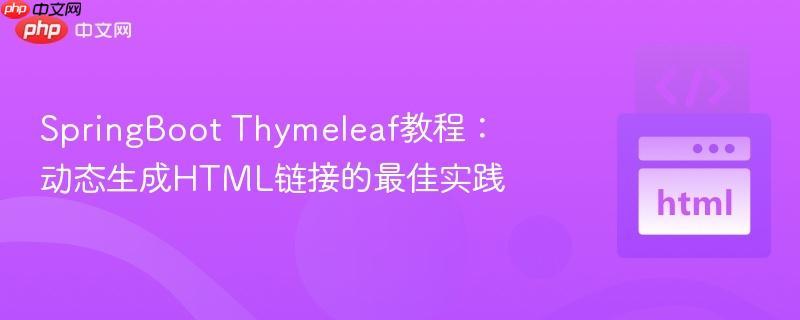
本教程详细介绍了在springboot应用中,如何利用thymeleaf模板引擎动态生成html链接。通过使用`th:href`属性结合thymeleaf的url表达式`@{${variable}}`,开发者可以轻松地将后端模型中传递的url数据渲染为可点击的超链接,从而提升前端交互性和数据展示的灵活性。
在现代Web应用开发中,动态地在前端页面展示后端数据是核心需求之一。特别是在使用SpringBoot和Thymeleaf构建Web应用时,我们经常需要将数据库或其他服务中获取的URL字符串渲染为可点击的超链接。本文将详细指导您如何在Thymeleaf模板中实现这一功能。
Thymeleaf提供了一套强大的URL表达式语法,用于处理各种链接场景。其中,最常用的是@{...}。当我们需要从后端模型中获取一个动态的URL字符串并将其作为链接的href属性时,我们需要将Thymeleaf的变量表达式${...}嵌套在URL表达式@{...}中。
将它们结合起来,就形成了th:href="@{${variableName}}",这表示从模型中获取variableName的值,并将其作为链接的href属性。
首先,我们需要在Spring Boot的后端控制器中准备包含URL数据的数据模型。假设我们有一个Person对象,其中包含name、position和homepage(一个URL字符串)字段。
立即学习“前端免费学习笔记(深入)”;
package com.example.demo.controller;
import com.example.demo.model.Person;
import org.springframework.stereotype.Controller;
import org.springframework.ui.Model;
import org.springframework.web.bind.annotation.GetMapping;
import java.util.Arrays;
import java.util.List;
@Controller
public class MyController {
@GetMapping("/rest")
public String list(Model theModel) {
// 模拟从数据库或其他服务获取数据
List<Person> people = Arrays.asList(
new Person("John Doe", "Software Engineer", "https://www.johndoe.com"),
new Person("Jane Smith", "Project Manager", "https://www.janesmith.net"),
new Person("Peter Jones", "UX Designer", "https://www.peterjones.org")
);
// 将数据添加到Spring模型
theModel.addAttribute("peopleList", people);
return "menu-list"; // 返回Thymeleaf模板的名称
}
}为了使上述代码能够运行,我们需要定义一个简单的Person模型类:
package com.example.demo.model;
public class Person {
private String name;
private String position;
private String homepage; // 存储URL字符串
public Person(String name, String position, String homepage) {
this.name = name;
this.position = position;
this.homepage = homepage;
}
// Getters
public String getName() {
return name;
}
public String getPosition() {
return position;
}
public String getHomepage() {
return homepage;
}
// Setters (可选,如果不需要修改数据)
public void setName(String name) {
this.name = name;
}
public void setPosition(String position) {
this.position = position;
}
public void setHomepage(String homepage) {
this.homepage = homepage;
}
}在menu-list.html模板中,我们将迭代peopleList,并为每个Person对象的homepage字段生成一个可点击的链接。
<!DOCTYPE html>
<html lang="en" xmlns:th="http://www.thymeleaf.org">
<head>
<meta charset="UTF-8">
<title>人员列表</title>
<style>
table {
width: 100%;
border-collapse: collapse;
}
th, td {
border: 1px solid #ddd;
padding: 8px;
text-align: left;
}
th {
background-color: #f2f2f2;
}
</style>
</head>
<body>
<h1>人员信息列表</h1>
<table>
<thead>
<tr>
<th>姓名</th>
<th>职位</th>
<th>个人主页</th>
</tr>
</thead>
<tbody>
<!-- 迭代控制器中传递的 peopleList -->
<tr th:each="person : ${peopleList}">
<td th:text="${person.name}"></td>
<td th:text="${person.position}"></td>
<!-- 动态生成链接 -->
<td>
<a th:href="@{${person.homepage}}" th:text="${person.homepage}" target="_blank"></a>
</td>
</tr>
</tbody>
</table>
</body>
</html>在上述代码中,关键部分是:
<td>
<a th:href="@{${person.homepage}}" th:text="${person.homepage}" target="_blank"></a>
</td><!-- 显示用户姓名作为链接文本 -->
<td><a th:href="@{${person.homepage}}" th:text="${person.name} + '的主页'" target="_blank"></a></td>
<!-- 显示固定文本作为链接文本 -->
<td><a th:href="@{${person.homepage}}" th:text="访问主页" target="_blank"></a></td>通过本教程,您应该已经掌握了在SpringBoot应用中使用Thymeleaf动态生成HTML链接的方法。核心在于利用th:href属性结合嵌套的URL表达式@{${variable}},将后端模型中的URL数据无缝地渲染到前端页面。遵循这些实践,您可以构建出更加灵活和用户友好的Web界面。
以上就是SpringBoot Thymeleaf教程:动态生成HTML链接的最佳实践的详细内容,更多请关注php中文网其它相关文章!

HTML怎么学习?HTML怎么入门?HTML在哪学?HTML怎么学才快?不用担心,这里为大家提供了HTML速学教程(入门课程),有需要的小伙伴保存下载就能学习啦!

Copyright 2014-2025 https://www.php.cn/ All Rights Reserved | php.cn | 湘ICP备2023035733号